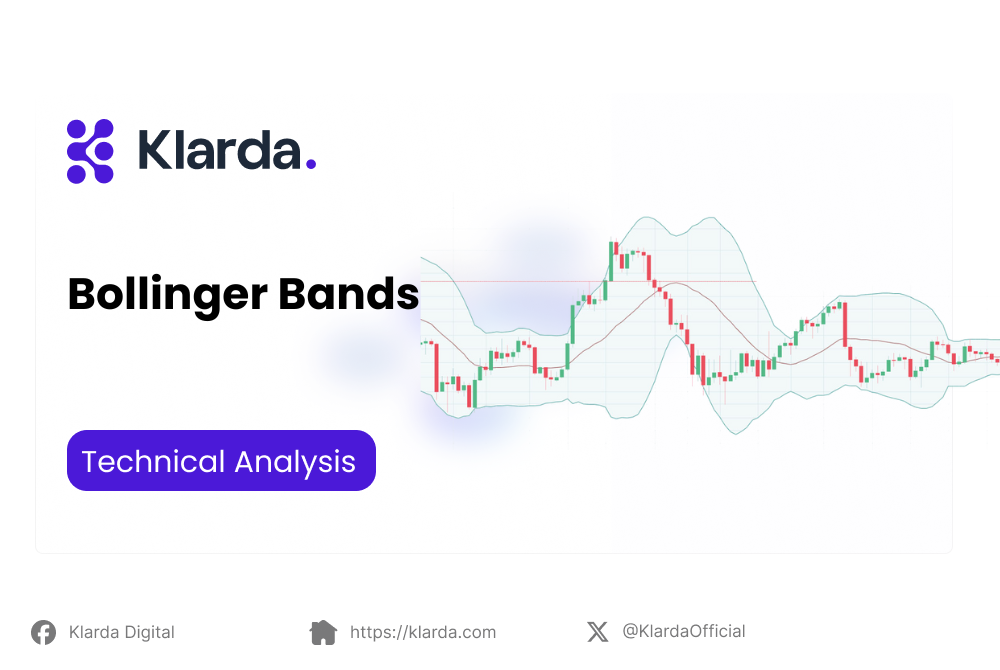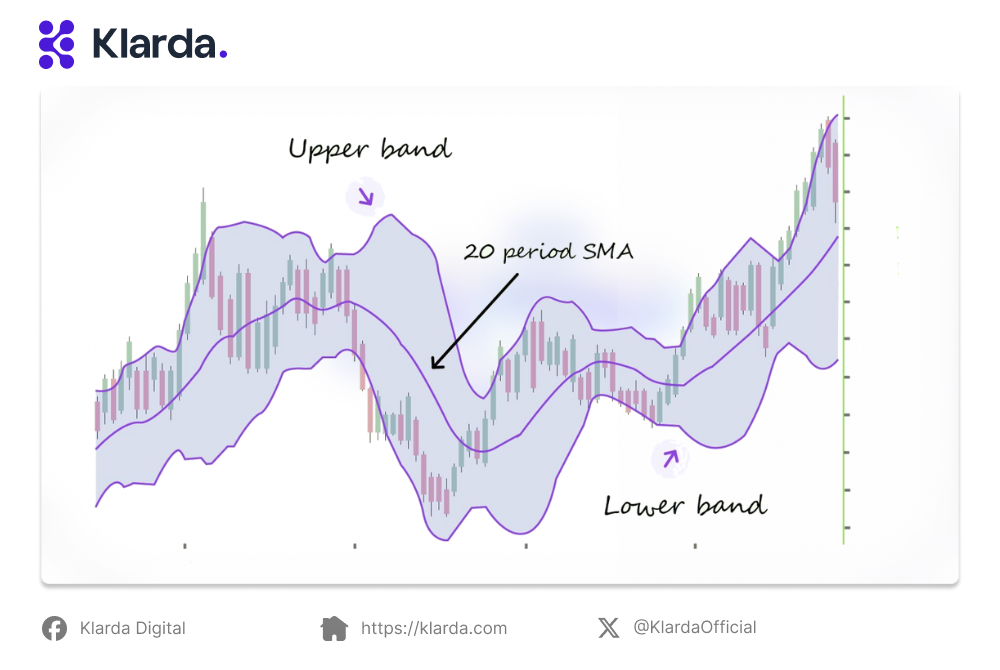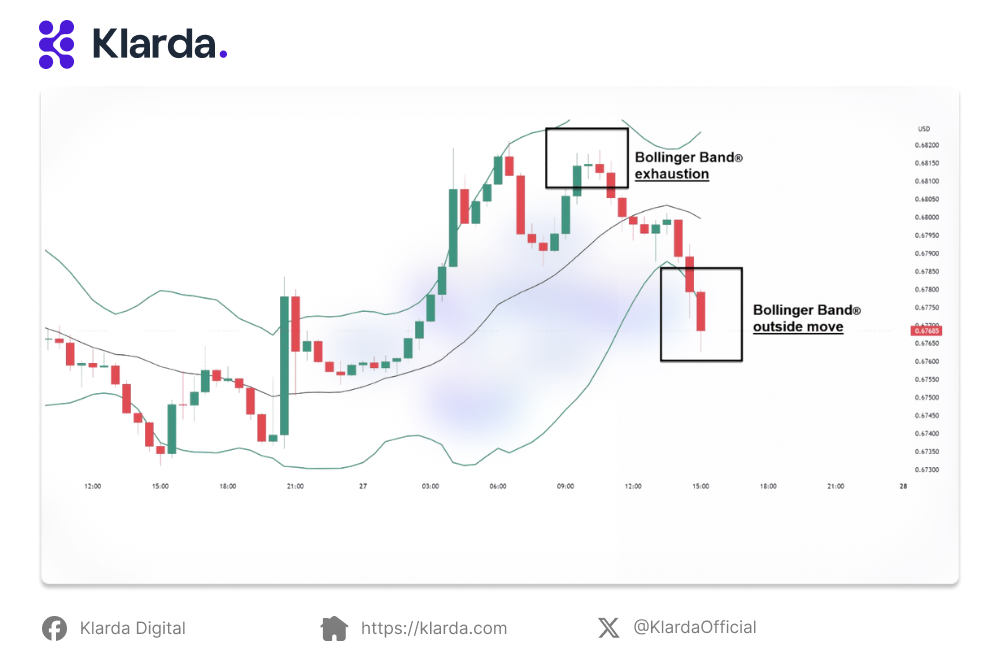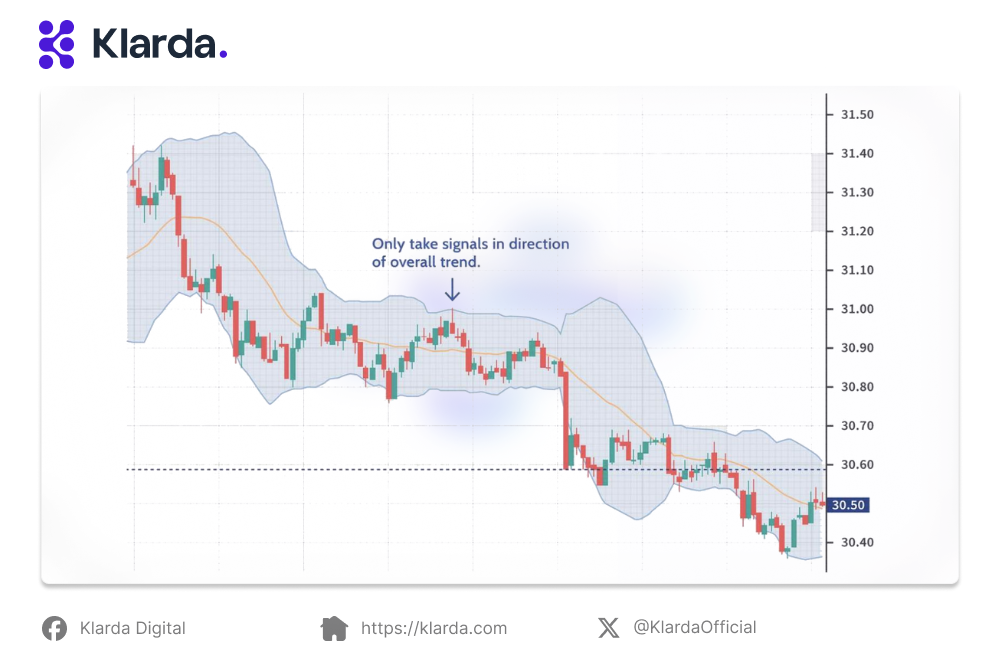Bollinger Bands
The Bollinger Bands stand out as a frequently employed technical analysis indicator, serving as a fundamental element for those involved in the market.
Among these indispensable tools stands the Bollinger Bands, a widely used technical analysis indicator that has become a cornerstone for market participants. This article embarks on a comprehensive journey to demystify Bollinger Bands, exploring its definition and draw comparisons with other prominent indicators like MACD. Real-world examples will showcase the practical applications of Bollinger Bands, providing valuable insights for traders navigating the complexities of the financial markets.

KEY TAKEAWAYS
- Bollinger Bands, developed by John Bollinger in the 1980s, are a popular technical analysis tool used to assess volatility and potential price reversals in financial markets.
- The formula for Bollinger Bands is as follows:
- Upper Band=Middle Band+(Multiplier×Standard Deviation)
- Lower Band=Middle Band−(Multiplier×Standard Deviation)
- The width of the bands provides a visual representation of market volatility.
WHAT ARE BOLLINGER BANDS?
John Bollinger introduced Bollinger Bands in the early 1980s as a tool to provide more insight into price volatility. Over the years, the indicator has gained widespread acceptance among traders and analysts for its effectiveness in capturing market dynamics.
Bollinger Bands indicator consists of a middle band, typically a 20-period simple moving average (SMA). These outer bands dynamically adjust to market volatility, expanding during periods of increased volatility and contracting during calmer market conditions.
The key features of Bollinger Bands lie in their ability to visually represent volatility and identify potential turning points in price trends. As prices move closer to the upper band, the security is deemed overbought, while prices nearing the lower band signal oversold conditions. The bands serve as dynamic Bollinger Bands support and resistance levels, aiding traders in making decisions about potential breakouts or trend reversals.
HOW TO CALCULATE BOLLINGER BANDS?
Calculating Bollinger Bands involves a straightforward process, with the following steps:
- Calculate the Middle Band (20-day SMA): Compute the simple moving average of the closing prices over a specified period (commonly 20 days).
- Calculate Standard Deviation: Determine the standard deviation of the closing prices over the same period used for the middle band calculation.
- Compute Upper and Lower Bands: Add and subtract the standard deviation value from the middle band to establish the upper and lower Bollinger Bands.
Bollinger Bands formula is as follows:
- Upper Band=Middle Band+(Multiplier×Standard Deviation)
- Lower Band=Middle Band−(Multiplier×Standard Deviation)

Calculating Bollinger Bands involves a straightforward process
WHAT DO BOLLINGER BANDS TELL INVESTOR?
Bollinger Bands offer several benefits to investors, such as:
- Volatility Measurement: The width of the bands provides a visual representation of market volatility. Narrow bands suggest low volatility, while wide bands indicate high volatility.
- Overbought and Oversold Conditions: Bollinger Bands help identify overbought and oversold conditions, providing potential entry and exit points for traders.
- Trend Reversal Signals: Price touching or exceeding the upper or lower band may indicate a potential trend reversal, offering valuable insights for traders.
Bollinger Bands vs. MACD:
While both Bollinger Bands and MACD are popular indicators, they serve different purposes. Bollinger Bands focus on volatility and potential price reversals, whereas MACD is a momentum oscillator. Bollinger Bands can help identify overbought and oversold conditions, while MACD is effective in capturing the strength and direction of a trend.
Bollinger Bands vs. RSI:
In summary, while Bollinger Bands and RSI serve distinct purposes in technical analysis, traders often use them in conjunction to gain a more comprehensive understanding of market conditions. Bollinger Bands offer insights into volatility and potential reversals, while RSI provides information about the strength and potential exhaustion of a trend. The combination of these two indicators can enhance a trader's ability to make informed decisions in dynamic market environments.
EXAMPLE OF BOLLINGER BANDS
Bollinger Bands, with their unique ability to gauge market volatility and potential price reversals, find diverse applications in trading. Here are some highlighted examples of how to use Bollinger Bands:
Trend Confirmation:
Traders often use Bollinger Bands trading strategy to confirm existing trends in asset prices. In an upward trend, prices tend to hug the upper band, while in a downtrend, they gravitate towards the lower band. The width of the bands also provides a visual cue – a widening gap indicating a strengthening trend, and a narrowing gap suggesting a potential weakening or consolidation.
Volatility Breakouts:
How to use Bollinger Bands for day trading? Bollinger Bands are adept at identifying periods of increased volatility. When prices break out beyond the upper or lower band, it signifies heightened market activity. For instance, if prices breach the upper band, it may indicate a strong bullish move, prompting traders to consider long positions.
Reversal Signals:
How to trade Bollinger Bands? One of the hallmark uses of Bollinger Bands is in identifying potential trend reversals. When prices touch or surpass the upper band, it could signal an overbought condition, suggesting a potential reversal to the downside. Conversely, when prices touch or breach the lower band, it may indicate an oversold condition, signaling a potential reversal to the upside.

One of the hallmark uses of Bollinger Bands is in identifying potential trend reversals
Bollinger Bands Squeeze:
The Bollinger Bands Squeeze is a phenomenon characterized by the bands contracting, indicating reduced volatility and a potential upcoming price breakout. Traders keenly watch for this squeezing effect, as it often precedes significant market movements. Once the squeeze is released, and the bands expand, it may signal the beginning of a new trend.
RSI and Bollinger Bands Combination:
How to read Bollinger Bands? Traders often combine Bollinger Bands with other indicators for a more comprehensive analysis. The Relative Strength Index (RSI) is commonly used in conjunction with Bollinger Bands. Conversely, if prices touch the lower band, and the RSI indicates oversold conditions, it adds weight to a potential upward reversal.
Mean Reversion Strategy:
Traders employing mean Bollinger Bands strategy look for instances where prices deviate significantly from the moving average (middle band). If prices extend beyond the upper band, suggesting overbought conditions, mean reversion traders might anticipate a pullback towards the average. Similarly, if prices dip below the lower band, indicating oversold conditions, a mean reversion trader might anticipate a bounce back towards the average.
Bollinger Bands as Support and Resistance:
The middle band of the Bollinger Bands indicator, often a 20-day Simple Moving Average, serves as a dynamic support or resistance level. Traders observe how prices react when approaching this middle band. A bounce off the middle band may indicate a continuation of the current trend, while a breach and sustained move beyond it could suggest a potential trend change.

The middle band of the bollinger bands indicator, often a 20-day Simple Moving Average, serves as a dynamic support or resistance level
In conclusion, Bollinger Bands stand as a versatile tool for traders and investors, providing valuable insights into market volatility and potential price reversals. Understanding how to calculate and interpret Bollinger Bands equips market participants with a valuable edge in navigating dynamic market conditions. Careful investigation, continuous learning, and strategic application of technical indicators like Bollinger Bands empower traders to navigate trends, assess market dynamics, and make prudent decisions.
Updated 7 months ago